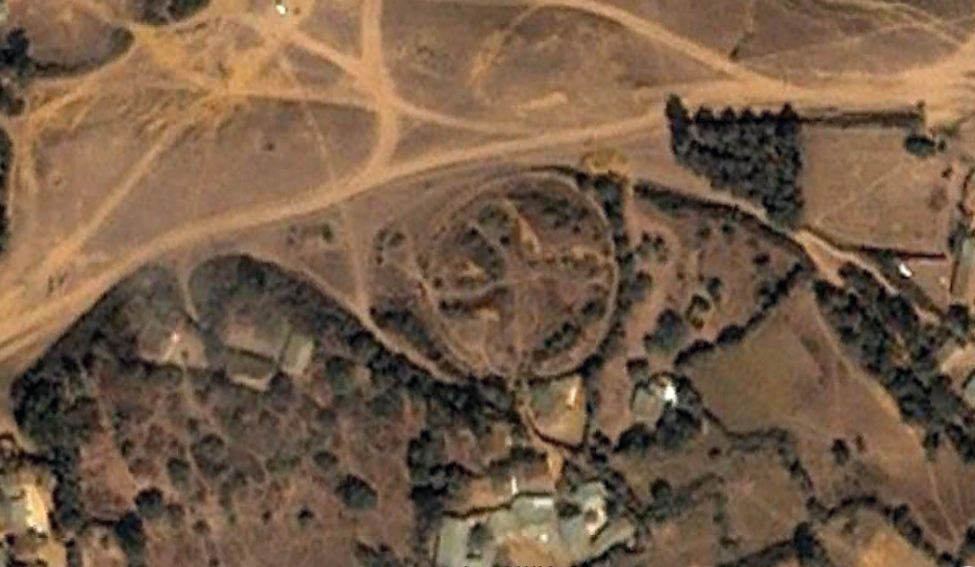Kadath
Mzora Stone Circle
The Mzora Stone Circle is a huge megalithic monument in Morocco and is in fact the largest stone ellipse in the world. Mzora and the Egyptian Nabta Playa site are claimed to have used the same construction methods that Alexander Thom has shown to have been used by the British megalith builders. A recent article by Sarah P. Young claims that “The circle is constructed using a Pythagorean right angled triangle with the ratios 12, 35, 37 and this is the same method used by 30 megalithic stone circles in Britain alone. Other similarities in construction and proportions exist such as the use of the so called ‘megalithic yard – a unit of measurement which seems to have been universally employed across Europe – and evidently even further afield” (g).
Although no formal claim has been made for any connection with Atlantis, the supporters of the idea that the megalith builders were Atlanteans see the complexity of the Mzora site as further justification for their opinion. A July 2018 paper(f) links the ancient Berbers with Mzora and as the Berbers occupied territory described by Plato as Atlantean (Timaeus 25a-b & Critias 114c), Mzora may also be legitimately described as Atlantean.
James Mavor, better known for his research at Santorini, surveyed the Mzora site in the 1970s. Bob Quinn visited the site in 1982 and was struck by its similarity with Newgrange! Robert Temple discusses the site at length in his Egyptian Dawn[736].>According to Hugh Newman in a paper on the global ubiquity of stone circles(h), he refers to Mavor’s work and notes that Mzora “appears to have been constructed either by the same culture that erected the megalithic sites in France, Britain and Ireland or by one that was intimately connected with them.”<
John E. Palmer visited and surveyed the site in 1978 and subsequently wrote an article for Kadath magazine, unfortunately in French only. He reported that extensive damage was done to the site by ‘archaeologist’ César Luis de Montalban with excavations in 1935-6(d) and that many of the stones have been broken by ignorant Islamic extremists.
In 2011, Graham Salisbury gave coordinates for the site and offers a history of Mzora in a longer article(b).
(b) See: https://heritageaction.wordpress.com/2011/01/27/the-mysterious-moroccan-megalithic-menhirs-of-mzora/
(d) https://www.stonepages.com/news/archives/004222.html
(g) https://www.ancient-origins.net/ancient-places-africa/mzora-stone-circle-0011778
Kadath
Kadath is a French-language Belgian print magazine established in 1973. One of its founders was Jacques Gossart. The journal is dedicated to the investigation of archaeological mysteries and has frequently dealt with the subject of Atlantis. Its website(a) is worth a look as it includes sample articles.
A number of back issues are available free online(b).
(a) The Kadath Project (archive.org) *
(b) http://pdfarchive.info/index.php?pages/Ka – Link Broken*
Bajocco, Alf *
Alf Bajocco, an Italian expert on North Africa, published a paper in 1965 entitled The Early Inhabitants of the Canary Islands(a), in which he discussed the possibility that the earliest inhabitants of the archipelago had a Berber origin, who in turn had been descendants of the Atlanteans. Nearly half a century later the Berber connection was confirmed by genetic analysis(b). Bajocco claimed that the following dramatic climate changes in North Africa some of the Berbers migrated westward as far as the Canaries, while others went eastward settling in the Nile Valley.
In the 1960’s Bajocco speculated(d) on the ‘probability’ of Etruscan voyages to South America, citing the opinions of the Italian, Dr. Mario Gattoni Cellini, who claimed to have identified linguistic and other cultural similarities between the Etruscans and ‘Carib Shamanism’. Cellini’s speculations went so far as to suggest that the Aymara came from Crete and the Maya are akin to Sardinians!
In 1987, Bajocco published an article(c) in the Belgian journal Kadath comparing the ‘Bimini Wall’ with underwater features discovered off Lanzarote in the Canaries by Pippo Cappellano.
(a) The Early Inhabitants of the Canary Islands | Agraw.com *
(b) https://www.sciencedaily.com/releases/2009/10/091021115147.htm
(c) https://www.science-frontiers.com/sf058/sf058a02.htm
(d) Egerton Sykes’ Atlantis Vol 19.1 Feb/Mar 1966 p.3
Gossart, Jacques (L)
 Jacques Gossart is a French historian with a particular interest in the origins of civilisations, especially those of China and Egypt. He has also written an article for the French Orbs magazine(b) about the possible Chinese ancestry of the Olmecs.
Jacques Gossart is a French historian with a particular interest in the origins of civilisations, especially those of China and Egypt. He has also written an article for the French Orbs magazine(b) about the possible Chinese ancestry of the Olmecs.
He also, in collaboration with others, has written[340] about the search for Atlantis. Instead of trying to locate Plato’s submerged island, which they assume to have been in the North Atlantic, they have concentrated their efforts in trying to identify the survivors of the catastrophe. With this in mind they have investigated, the Basques, the Guanches and the North African Berbers as well as the possibility of links between Atlantis and ancient Egypt.
In 2011 he published a further book[882] on the subject of Atlantis, reviewing all the most recent discoveries and theories.
Gossart has also recently written[341] a history of the swastika symbol. He was also a founder of Kadath(a) a Belgian magazine devoted to the study of archaeological mysteries. It celebrated its 40th anniversary in 2013.
(b) https://www.orbs.fr/ Issue #5
Bimini Road/Wall
The Bimini Road/Wall is located in about ten feet of water off Paradise Point on Bimini Island in the Bahamas. It was investigated in 1968 by Dr. J. Manson Valentine, Jacques Mayol, Harold Climo and Robert Angove. The discovery coincided with the ‘prophecy’ of Edgar Cayce, the American  psychic, who pronounced in 1933 that parts of Atlantis would re-emerge in the late 1960s. His exact words are recorded as: “A portion of the temples may yet be discovered under the slime of ages and seawater near Bimini. Expect it in ‘68 or ‘69 – not so far away.”
psychic, who pronounced in 1933 that parts of Atlantis would re-emerge in the late 1960s. His exact words are recorded as: “A portion of the temples may yet be discovered under the slime of ages and seawater near Bimini. Expect it in ‘68 or ‘69 – not so far away.”
Naturally, there was intense media interest and the idea of Atlantis in the Americas was given a new lease of life. Unfortunately, the exact nature of this unusual ‘J’ shaped feature was fiercely debated and controversy continues to this day. Eugene A. Shinn, a geologist and devout sceptic, has offered(a) a more critical interpretation of the Bimini discoveries. In an article in Nature magazine some years ago>(Vol. 287, 4 September 1980) Shinn and Marshall McKusick described Cayce followers as members of ‘a cult’.(h)
>Peter James in The Sunken Kingdom [047.53] commented on the Bimini controversy noting that “If the ‘Road’ were man-made we would not expect the grains and microstructure within the stones to be consistent from one ‘block’ to another. Yet they proved to be so, in every conceivable test test that was applied, showing that they were laid by natural means. Further, radiocarbon tests on shells included in the stones show that the ‘Road’ was formed between only 2,500 and 3,500 years ago, far short of the 11,000 years believed by Atlantologists.”<
Greg Little offered a vigorous refutation of Shinn’s claims in an article in the May/June 2006 edition of Atlantis Rising magazine(g). Little continued his criticism of Shinn in a 2017 article(e).
Without wishing to rain on anybody’s parade it should be pointed out that Manson Valentine was a fan of Cayce’s and as a consequence, it has sometimes been inferred that the date of his discovery might have been engineered to agree with Cayce’s prediction and enhance the subsequent publicity. Lynn Picknett & Clive Prince have pointed out[705.61] that the Bimini Road was known to the local islanders for years and even offered to show it to its eventual ‘discoverers’!
A comparable alignment of blocks in 22 metres of water was found off the coast of Lanzarote in the Canaries and originally reported in the Belgian magazine Kadath in 1987 and noted in the Science Frontiers website(d).
The Bahamas Geotourism website offers the following additional information “In the 1930s, an American psychic named Edgar Cayce reported that he had spoken with a person who had lived in the Lost City of Atlantis in a former life. This Atlantean told Cayce that Atlantis had been near Bimini.”(i). I have been unable to verify the source of this embellishment.
Dr David Zink carried out a detailed examination of the Bimini Road, which he outlined in his own book, The Stones of Atlantis[178]. Zink’s conclusion was to accept that Atlantis had been situated in the Atlantic but regarded “Bimini as an Atlantean colonial site or the location of a different culture parallel in time to Atlantis.” Not the ringing endorsement one might have expected.
In an interview with Peter Tompkins son, Ptolemy, he revealed that his “dad was convinced that the Edgar Cayce readings about the rising of Atlantis were correct. He spent thousands and thousands of dollars photographing the limestone formations off Bimini – the so-called “Bimini Road.” My father loved the idea of Atlantis returning because he wanted the world to become a kind of new Eden. He was a true father of the New Age in this sense – he had the core New Age belief that the world once was, and would be again a better place. But not better in some mundane sense, but in the sense of being elevated back into a spiritualised condition that it had fallen away from. That’s what the Bimini stuff was all about.”(j) Tompkins left Bimini unconvinced that it had Atlantean credentials.
A local Bimini writer and healer, Ashley B. Saunders, has produced a definitive two-volume history[179] of the island as well as a book[180] on Atlantis. Saunders has been described as “the gatekeeper of Atlantis”(c).
The most recent study of structures off the coast of Bimini by a team that included Greg Little and William Donato in 2005 and 2006, when Andrew Collins joined them, has produced evidence of ancient harbours that are now submerged at two locations. They also discovered a number of stone anchors, now in the Bimini Museum. However, acceptance of the reality of this evidence is a long way from proving any connection with Atlantis.
Gavin Menzies, a supporter of the Minoan Hypothesis has speculated, in his book 1421[0939], he speculated that the Chinese fleet suffered damage during a storm and landed at Bimini where they used their large square ballast stones to build an emergency drydock, the remains of which is now the Bimini Road!
A YouTube film including an interview with Greg Little is worth viewing(b). Less interesting is a new documentary from Amazon Prime, aided and abetted by the UK’s Daily Express, which has apparently resurrected some interest in the Atlantis – Bimini connection(f).
(b) https://www.youtube.com/watch?v=3DbaA6NItNQ
(c) https://www.finalcall.com/artman/publish/printer_8736.shtml
(d) https://www.science-frontiers.com/sf058/sf058a02.htm
(e) https://apmagazine.info/index.php?option=com_content&view=article&id=956
(h) https://www.academia.edu/12724731/Bahamian_Atlantis_reconsidered

